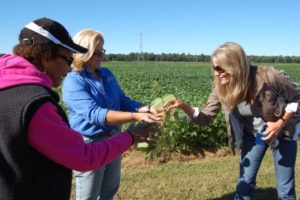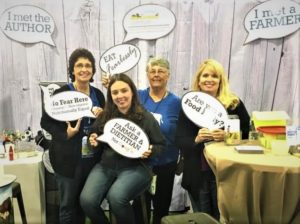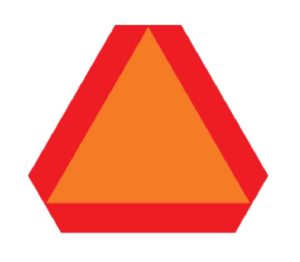Volunteer Farm Women Connect to Correct Misinformation about Farming and Food
Family farms on Delmarva, and across America, have helped build the safest and most affordable food supply in the world. Women play a vital role in running the farm and growing the nation’s food supply. For the past decade, they have been speaking up to tell their story through CommonGround, a national grassroots program designed to connect the women who grow food to the women who buy it.
Born of a partnership between, and funding from, the United Soybean Board and the National Corn Growers Association, CommonGround created a network of 200 women farmers across 20 states to listen to consumer concerns and talk with them about how food and farm products are raised on their own farm. CommonGround members take to the airwaves, blogs, national and local events and social media to provide knowledgeable advocacy and science-backed research. While the program provides a platform for the volunteers to tell their stories, the opinions and statements made by the volunteers are their own. Because of their passion and love for farming, these farm women are anxious to share what really happens on their farms and answer consumers’ questions.

Volunteer Jennie Schmidt shares her experiences of growing organic and traditional crops during a tour of her farm.
“Being both a farmer and a Registered Dietitian, advocacy was something I had been doing connecting consumers from farm to table, and this opportunity called “CommonGround” provided me with an additional avenue to reach more people and a specific audience of urban and suburban moms,” said Jennifer Schmidt, one of CommonGround’s first volunteers. “CommonGround has made significant inroads in bridging the gap between urban and suburban consumers and the farm women of CommonGround, providing transparent information about food and farming and authentic stories of life on the farm. Beyond my own social media platforms, CommonGround has opened up for me a broader audience and greater accessibility to consumers as well as a network of farm women I can rely on for assistance and support.”
The MidAtlantic chapter of CommonGround began in March of 2012 and is supported through a partnership between the Maryland Soybean Board and the Maryland Grain Producers Utilization Board. It has reached consumers going to where they shop, play and seek information at food shows, sporting events, community festivals, on-farm tours, speaking engagements, state dietitian meetings, and at the nation’s largest dietetic exposition, the “Food and Nutrition Conference and Exposition” at the annual meeting of the Academy of Nutrition and Dietetics.

CommonGround volunteers Paul Linthicum, Kelly Vaughan and Belinda Burrier join author Michele Payn in conversing with dietitian and nutrition professionals at annual conference.
Paula Linthicum is a mom, grandmom and farmer raising corn and soybeans in Montgomery county. She says she is frequently asked about sustainability and the environment at CommonGround events. “The soil is our partner and the home of our plants, and healthy plants need healthy soil,” explained Linthicum. “One of the sustainability practices we use is cover crops, which is planting wheat or a radish mix after soybean or corn harvest. This covers the ground to reduce soil erosion during the winter and actually recycles unused nutrients from the soybeans or corn.”
Amidst the pandemic, CommonGround identified consumers’ interest in knowing how to prepare healthy meals at home and created a virtual cooking series. Simple but delicious recipes with familiar ingredients were prepared with chef instructions on safe cooking measures. The series featured open conversations about the meals and a wide array of common food questions surrounding topics such as GMOs, gene editing, pesticides and hormones in meat and milk.
CommonGround’s website and social media outreach is a great place to go for quick food and farming answers that are straight from the farm and backed by science. They also provide a window into the operations of most every type of farm imaginable. While each volunteer brings different experiences and expertise to the table, they share the same goal—to provide the region with answers to their farming and food questions.
Find us online:
- Website: www.FindOurCommonGround.com
- YouTube: www.youtube.com/FindOurCommonGround
- Twitter: www.twitter.com/CommonGroundNow
- Twitter Hashtag: #CGConvo
- Facebook: www.facebook.com/CommonGroundNow
About CommonGround: CommonGround is a grassroots group of women farmers across the nation having conversations about the food they grow. CommonGround farmers volunteer their time to share personal experiences, as well as science and research, to help consumers sort through the myths and misinformation surrounding food. CommonGround was developed by the national checkoffs of the National Corn Growers Association and United Soybean Board and is implemented locally through the Maryland Soybean Board and the Maryland Grain Producers Utilization Board.
About Maryland Soybean Board: With a value of $173 million to the state’s economy, soybeans are one of Maryland’s top crops. The Maryland Soybean Board works to maximize the profitability of Maryland soybean producers by investing Maryland checkoff funds in research, promotion, and communication projects. Learn more about soybeans in Maryland by visiting www.mdsoy.com.
About Maryland Grain Producers Utilization Board: The Maryland Grain Producers Utilization Board was established in 1991 to administer the Maryland Grain Checkoff Program. Grain producers in Maryland voted to institute this voluntary checkoff program, which is funded by participating growers donating 0.5% of each Maryland bushel sold. With this funding, the board can fulfill its mission to increase the profitability of Maryland grain production and to improve public understanding of agriculture through promotion, education, and research.
Spring into Action and Be Seen
Salisbury, MD (March 8, 2021) – Spring brings planting season for Delaware and Maryland farmers. That means more tractors pulling planters and other farm equipment down highways and roads across the state. That also means increased potential for farm-equipment-related accidents between motorists and those farmers.
“We encourage farmers to avoid high traffic times, busy roads, and most of all, have equipment well marked,” says Belinda Burrier, Maryland Soybean Board Chair. “All farm equipment should have flashing lights, reflective tape, and the slow moving vehicle emblem.”
The federal Agricultural Machinery Illumination Safety Act requires all agricultural implements manufactured after 2017 to be equipped with roadway lighting and marked in accordance with current American Society of Agricultural and Biological Engineers standards. The federal law also requires turn signals and amber marking lights.
“Reflective tape and new LED lights not requiring electrical power make it simpler to bring older equipment up to current lighting and marking standards,” continued Burrier. “With farm accidents on the rise, being seen is critical to avoiding rural farm crashes.”
 The slow moving vehicle (SMV) emblem is required on all vehicles traveling no more than 25 mph. For towed equipment, the emblem must be on both the towed attachment as well as the towing vehicle. This orange, fluorescent triangle was invented in 1963 in response to research showing that over half of the highway fatalities involving farm equipment were rear-end collisions. Interestingly, the emblem’s unique shape occurred as creators tested multiple designs. The triangle ends would catch and rip researchers’ clothing, so the corners were removed from the triangle to create the unique shape of the SMV emblem.
The slow moving vehicle (SMV) emblem is required on all vehicles traveling no more than 25 mph. For towed equipment, the emblem must be on both the towed attachment as well as the towing vehicle. This orange, fluorescent triangle was invented in 1963 in response to research showing that over half of the highway fatalities involving farm equipment were rear-end collisions. Interestingly, the emblem’s unique shape occurred as creators tested multiple designs. The triangle ends would catch and rip researchers’ clothing, so the corners were removed from the triangle to create the unique shape of the SMV emblem.
The emblem is gaining new attention as the mascot for the www.FindMeDriving.com campaign, supported by the Delaware and Maryland Soybean Boards. Through the acronym name of SAM, the mascot reminds drivers to Slow down, Assess their surroundings, and Move with caution, when driving near SMVs. The site also offers road safety tips, equipment requirements and resources for SMV drivers.
“We encourage farmers to make it a habit to check that all lights are in working order and the SMV emblem is bright and in place before driving on roads,” commented Cory Atkins, Chair of the Delaware Soybean Board. “Your safety, the safety of your equipment, and the neighbor driving on the road are at risk. Let’s do all we can to be seen and avoid a costly accident.”
###
Road Safety Campaign Highlights Awareness of Farm Equipment Drivers for Motorists
Maryland motorists can help reduce farm-related accidents.
The Maryland Soybean Board, with support from the United Soybean Board, is partnering in the “Find Me Driving” road safety campaign to raise motorists’ awareness of farm equipment drivers on the roads this spring.
“As rural accidents are increasing in number with greater physical and economic losses, the Maryland Soybean Board proactively identified farm vehicle road safety awareness as a priority and launched the campaign,” commented Belinda Burrier, MSB Chair and USB Director. “We are delighted that our fellow soybean organizations are joining in this safety initiative.”
According to data from the National Highway Traffic Safety Administration, only 30% of the total vehicle miles traveled in 2017 were in rural areas, yet 46% of all traffic fatalities in 2017 occurred in rural areas. The fatality rate per 100 million vehicle miles traveled in the U.S. was 2.1 times higher in rural areas than urban areas. Every state reported a higher percent of rural area fatalities than urban areas.
“As farm planting season activity increases this spring, drivers can increase awareness to help prevent accidents,” continued Burrier. “These helpful resources are available for everyone to use to learn about what to look for on rural roads and how to prepare for safely navigating rural roads in our region.”
 Online Find Me Driving campaign resources feature SAM, the campaign’s mascot, whose name means ‘Slow down, Assess your surroundings, Move with caution’ and resembles the high-reflectance slow moving vehicle triangle emblem required on all vehicles traveling under 25 mph. Visitors to the site can find tips about how to safely drive when encountering farm equipment and encourages motorists to look for the bright orange triangle on tractors, combines, maintenance trucks and other large, slow-moving vehicles. Resources also include lighting and marking guidelines for farm equipment, as well as tips when driving slow moving vehicles in traffic.
Online Find Me Driving campaign resources feature SAM, the campaign’s mascot, whose name means ‘Slow down, Assess your surroundings, Move with caution’ and resembles the high-reflectance slow moving vehicle triangle emblem required on all vehicles traveling under 25 mph. Visitors to the site can find tips about how to safely drive when encountering farm equipment and encourages motorists to look for the bright orange triangle on tractors, combines, maintenance trucks and other large, slow-moving vehicles. Resources also include lighting and marking guidelines for farm equipment, as well as tips when driving slow moving vehicles in traffic.
“Our state is small in size but ranks fifth in population density, which increases the chances Maryland motorists will encounter farm vehicles and equipment on public roads,” concludes Burrier. “We want drivers to be prepared and arrive home safe.”
About Maryland Soybean Board: With a value of $173 million to the state’s economy, soybeans are one of Maryland’s top crops. The Maryland Soybean Board works to maximize the profitability of Maryland soybean producers by investing Maryland checkoff funds in research, promotion, and communication projects. Learn more about soybeans in Maryland by visiting www.mdsoy.com.
About United Soybean Board: United Soybean Board’s 78 volunteer farmer-directors work on behalf of all U.S. soybean farmers to achieve maximum value for their soy checkoff investments. These volunteers invest and leverage checkoff funds in programs and partnerships to drive soybean innovation beyond the bushel and increase preference for U.S. soy. That preference is based on U.S. soybean meal and oil quality and the sustainability of U.S. soybean farmers. As stipulated in the federal Soybean Promotion, Research and Consumer Information Act, the USDA Agricultural Marketing Service has oversight responsibilities for USB and the soy checkoff. For more information on the United Soybean Board, visit unitedsoybean.org.
Contact: Danielle Farace, Executive Director
Maryland Soybean Board
Office: 443.812.4526
danielle@mdsoy.com
Soybean Farmers Applaud Maryland Department of Transportation
Maryland Soybean Board to partner in education outreach
The Maryland Soybean Board praises the Maryland Department of Transportation for their innovative consideration of farmers in their recently released 2021-2025 Maryland Strategic Highway Safety Plan (SHSP). The plan is the latest update to identify strategies and actions to eliminate fatalities on all Maryland roadways. This update is the first of which to address rural communities and farm equipment concerns.
“The SHSP addresses safety specific to Maryland roadways across urban, suburban and rural communities,” states the Maryland Department of Transportation (MDOT) in the announcement of the plan. “For example, in many areas the roadway use changes when farm equipment needs to travel alongside other vehicles. In a case like this, crash prevention measures – such as fixed and mobile road signs warning of slow-moving vehicles and outreach campaigns – will be among strategies used to raise awareness of unique needs of rural communities and farm operations on Maryland roads.”
The Maryland Soybean Board (MSB) completed the Maryland Rural Road Safety Study in 2019, which analyzed farm vehicle and farm equipment related in the State of Maryland. Conclusions from the study found that education for all drivers, both of farm vehicles and standard motor vehicles, will play a key role in reducing the number of farm vehicle collisions; and that it was imperative for farm vehicles to be recognized in the SHSP. The Maryland Soybean Board worked with the Maryland Department of Agriculture and other stakeholders to put those findings into action.
“Road safety is a top priority for Maryland soybean farmers,” proclaimed MSB Chair Belinda Burrier. “We are pleased to see that the Maryland Department of Transportation is taking these concerns seriously by becoming one of the first states in the nation to include farm equipment in their highway safety plan.”
The MSB will continue to work with MDOT to further education efforts surrounding farm vehicle collisions. Most recently, MSB released www.findmedriving.com, a website providing driving tips for navigating around slow moving vehicles on the roadway. It features an orange triangle mascot, SAM, as a reminder for drivers for when they see a slow moving vehicle to Slow down, Assess their surroundings, and Move with caution. Burrier has also been appointed to represent farmers on the MDOT Motor Vehicle Administration Highway Safety Speed Emphasis Area Team.
“Serving in this role, I look forward to not only sharing my experience to prevent farm vehicle collisions, but also voicing concerns on other opportunities to make roadways safer for farmers, including roadway construction, maintenance, and more,” she states.
In Maryland, farmers grow about a half a million acres of soybeans, producing more than 20 million bushels of beans each year. With a value of $173 million to the state’s economy, soybeans are one of Maryland’s top crops. The checkoff program is funded by farmers through an assessment of one-half of one percent of the net market value of their soybeans at the first point of sale. One-half of the checkoff funds stay in Maryland for programs; the other half is sent to the United Soybean Board.
For more information on the Maryland Soybean Board, visit www.mdsoy.com.
# # #
Danielle Farace, Executive Director
Maryland Soybean Board
Office: 443.812.4526
danielle@mdsoy.com
Archives
Baltimore Parents Will Cheer Soy-Backed Synthetic Lawn
Baltimore, MD. (APRIL 05, 2016) - The fields around the Baltimore County Center for Maryland Agriculture and Farm Park aren’t the only things greening up this spring. Inside the Exhibit Barn, a soft green synthetic “lawn,” featuring a soy-based backing, has sprung up....
Maryland Soybean Board Wins Maryland Cattlemen’s Association Award
Hagerstown, MD. (March 29, 2016) – The Maryland Soybean Board received the Top Hand Award from the Maryland Cattlemen’s Association during its annual convention earlier this month. The Top Hand Award recognizes an individual or organization that has contributed...
Maryland Farmers Are Breaking Records
Cover Crop Program Sees Best Participation Yet (ANNAPOLIS, MARYLAND) - A small airplane swoops low over a field of golden soybeans, and then zooms back up into the air before making another round at Schmidt Farms, located on the Eastern Shore of Maryland. “What we’re...
This Thanksgiving Season Be Thankful for Maryland’s Family Farms
November 25, 2015 – Thanksgiving is a time for food, family and fellowship. For Maryland family farmers, it’s also a time to be thankful that the year’s crops have been harvested and that their animals have had another year of superior care. Recently completed USDA...
Know Your SCN Numbers
Click here to download the latest information on SCN and find out how to have your soil tested.
Ice Cream is Part of This Farm’s Story
SALISBURY, MD. (July 19, 2015) –Ice cream may be ubiquitous to summer, but for one dairy farmer in Tuscarora, Md., this sweet treat is much more, it’s part of his family’s story. In 2009, Chuck Fry, and his wife, Paula, were looking for a way to diversify the income...
Maryland Soybean Board Funds Research
SALISBURY, MD. (June 16, 2015) – A multi-year project lead by the U.S. Geological Survey to monitor the nutrient quality and the age of groundwater as it leaves farm fields along the Upper Chester River continues in Queen Anne’s County. Funding the project for the...
Farm Stewardship Certification Program reaches 100-Farm Milestone
Smithsburg, Maryland (May 6, 2015): The 100th Maryland farm to be certified for achieving the highest level of environmental stewardship was recognized May 6th a ceremony outside Smithsburg, Md. Gardenhour Orchards, operated by Bill Gardenhour and his family, received...
Maryland Farmers Plant Record-Setting Cover Crop Acres
SALISBURY, MD. (March 3, 2015) – On a cold winter’s day with their fields blanketed in snow, farmers Dave and Linda Burrier don’t get a day off. There’s paperwork to do – lots of it. Maryland farms like Burrier Farms, located in Union Bridge, have to file a nutrient...
Summer Fairs to Feature Soy Product
SALISBURY, MD. (June 8, 2015) – Two Maryland fairs will showcase the versatility of “the miracle bean” thanks to support from the Maryland Soybean Board. First up is the Washington County Ag Expo and Fair, July 18-25 at the Washington County Agricultural Education...
